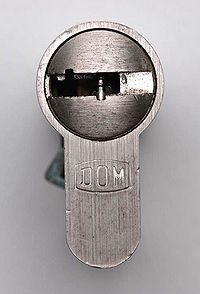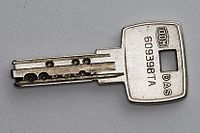Dimple
Dimple

A dimple lock is a pin-tumbler-based lock design that uses flat side of the key blade as a bitting area. Cuts on the bitting area resemble dimples, hence the name. This contrasts traditional pin-tumblers that use the edge of the blade as the primary bitting area. Most dimple locks orient the keyway of the lock perpendicular to the pin stacks and allow the key to be inserted in any orientation.
Dimple locks are used in a wide variety of applications, and may vary from low to high security. A dimple lock is not more secure when compared to traditional pin tumbler locks, but the untraditional nature of the key makes many dimple locks appear sophisticated. Some of the most notable dimple lock manufacturers are KABA, Mul-T-Lock, DOM, LIPS, and KESO.
History
Add to me!
Principles of operation

Traditional dimple locks are functionally equivalent to pin-tumblers. The only difference is the orientation of the keyway and the location and style of the bitting cuts on the key blade. More advanced dimple locks use various high-security features like key profiling, side pins, telescoping pins, and axial rotation. Additional passive and active locking mechanisms are also common, such as sidebars and moving elements within the key itself.
Modern dimple locks allow for pins to be positioned on all sides of the key, increasing key control and master keying capabilities. Traditional pin-tumblers have problems with increasing the number of pins in the lock past a certain point. This is caused by the need to extend the key to accomodate the extra pins, which leads to keys that easily bend or break.
Vulnerabilities
Dimple locks are vulnerable to all of the same attacks as traditional pin-tumbler locks:
Note
- Pick guns have limited effectiveness against dimple locks because of the poor range of motion allowed in the dimple keyway.
References
See also
| This article is a stub. You can help Lockwiki by expanding it. |
